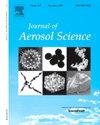On the use of EBRSM turbulence model to improve continuous random walk model prediction in inhomogeneous turbulent flows
IF 3.9
3区 环境科学与生态学
Q2 ENGINEERING, CHEMICAL
引用次数: 0
Abstract
In this paper the suitability of the normalized Langevin stochastic equation, coupled with the RMS fluctuations velocity predicted by EBRSM (Elliptic Blending Reynolds Stress Model) second order turbulence model, in inhomogeneous turbulent flows was studied. The gas-particle flow was numerically investigated by using OpenFOAM V9 CFD toolkit for two configurations. First, in a two-dimensional duct flow in which randomly distributed particles, with diameters ranging from 10 nm to 23 m, were introduced in the channel and followed by solving the particle equation of motion including the drag and Brownian forces under the one-way coupling assumption. The performance of the Continuous Random Walk (CRW) model with the EBRSM prediction of the Reynolds stress tensor for predicting the behavior of fluid-tracer and inertial particles in an inhomogeneous turbulent flow was examined as well as their deposition velocities. In addition, the particle laden flow inside an obstructed three dimensional channel was studied to evaluate the characteristics of particle deposition according to the ratio of rough-element spacing to its height e/H. Thus, the deposition rate on the different surfaces and the particles deposition profiles on the cavities between the rough-elements and on windward rib surfaces were evaluated for e/H = 4, 7 and 10. By exploring the concentration profiles and deposition velocities of particles, it was concluded that the Normalized-CRW model including EBRSM flow prediction leads to accurate and satisfying results, compared to the use of correlations for RMS fluctuations velocity values, and can be applied in more complex flows (such as in industrial configurations).
求助全文
约1分钟内获得全文
求助全文
来源期刊

Journal of Aerosol Science
环境科学-工程:化工
CiteScore
8.80
自引率
8.90%
发文量
127
审稿时长
35 days
期刊介绍:
Founded in 1970, the Journal of Aerosol Science considers itself the prime vehicle for the publication of original work as well as reviews related to fundamental and applied aerosol research, as well as aerosol instrumentation. Its content is directed at scientists working in engineering disciplines, as well as physics, chemistry, and environmental sciences.
The editors welcome submissions of papers describing recent experimental, numerical, and theoretical research related to the following topics:
1. Fundamental Aerosol Science.
2. Applied Aerosol Science.
3. Instrumentation & Measurement Methods.
 求助内容:
求助内容: 应助结果提醒方式:
应助结果提醒方式:


